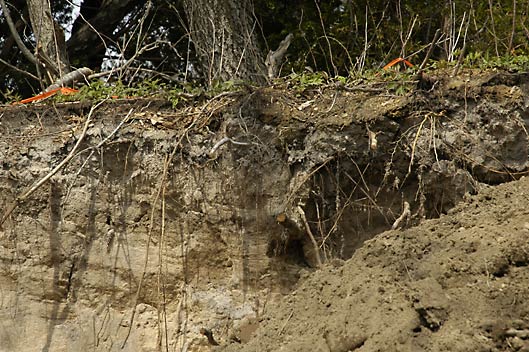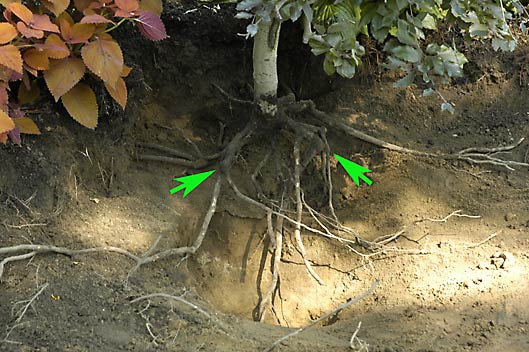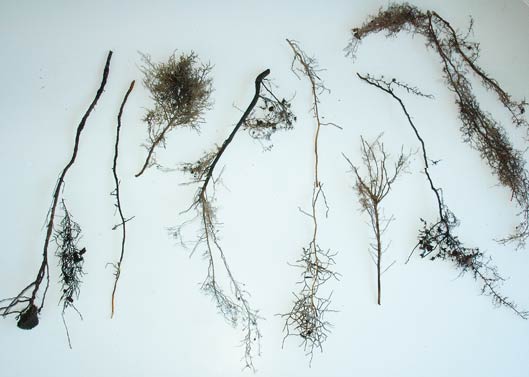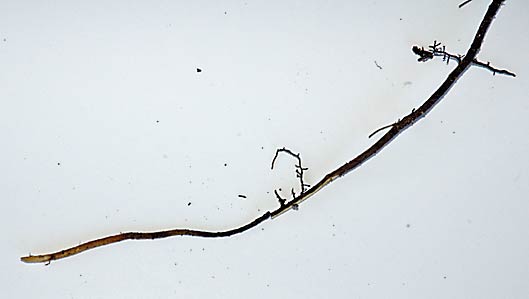 Photographs by Steven NikkilaRoots and branches: The connection
Photographs by Steven NikkilaRoots and branches: The connection
When a tree or shrub has roots residing in several properties, differing treatment in one section of the root zone might affect the plant’s entire crown or just one section. In some species, water moves from a given root along a certain path in the trunk to serve a particular branch. Root and branch are usually on the same side of the tree. In such “ring porous” species*, what happens to a given root affects a given branch. In other species, water follows a zig-zag or spiral pattern, so what comes from one root may serve various branches all over the crown.
This post oak lost most of its roots on one side as the hill was cut away preparatory to building a retaining wall. (Arrows mark clipped root ends.) It will almost certainly lose limbs on this side. Extra water for remaining roots, an arborist’s care, and pruning to remove dead wood are in order.
* Including American elm, arborvitae, black locust, catalpa, cherry, false cypress, hackberry, hickory, honeylocust, Kentucky coffee tree, many oaks, mulberry, persimmon, sassafras, walnut, white ash, and yellowwood.
 Even large roots can regenerate. These are the roots of a dwarf weeping beech. In two places you can see where the roots grew back from cut ends after the plant was dug from the field for sale. Bury a root, kill a tree? Nope!
Even large roots can regenerate. These are the roots of a dwarf weeping beech. In two places you can see where the roots grew back from cut ends after the plant was dug from the field for sale. Bury a root, kill a tree? Nope!
There’s oft-repeated advice about grade changes: Don’t put more than four inches of soil over tree roots. You’ll find it in Extension bulletins and gardening books. What you won’t find included is the basis for the advice. After much searching, I found the source and can assure you that in most cases, it doesn’t apply to what gardeners do.
The caution is based on grade changes at construction sites—large scale alteration of the entire root zone, executed with heavy equipment to spread and pack fill soil to builders’ and pavers’ specifications. By contrast, gardeners raise beds of loose soil, using a wheelbarrow and cover only portions of root systems. I’ve done it, dozens of times, and watched both the beds and trees closely, some for as many as 30 years. I’ve also interviewed professors of horticulture who have done the same in demonstration areas and we agree that loose soil over part of a root system, always kept away from the tree’s trunk, is no problem.
The same may apply to loose soil added over an entire root system. A team of University of California pathologists and Extension researchers filled over trees’ root systems with ten inches of soil in a test plot, settling that soil only with watering. In part of the field, tubing meant to bring oxygen into the soil was installed. The trees were sweet cherries, a species known to be intolerant of low soil oxygen situations. Yet “…no visible injury occurred. …no differences in plant growth, health or appearance…”
Gardener, bare that root ball!
Burlap and twine often remain intact and relatively strong for several years in-ground, repelling water and causing serious constriction to trunk and roots. Wire may persist for decades, partially or completely girdling first the flare roots and eventually the plant’s trunk.
So remove these impediments and killers at planting time. Set the balled-and-burlapped tree or shrub in the planting hole and then remove all twine, rope, wire and burlap from at least the top half of the ball.
For more, check:
Chapter 7, “Planting” of Principles and Practice of Planting Trees and Shrubs by Gary W. Watson and E. B. Himelick, or www.isa-arbor.com/education/onlineResources/cad/resources/educ_CAD_BBTrees_View.pdf
 Here are various species’ root fans I collected one day while transplanting, to illustrate colors, branching patterns and response to previous root pruning (branched tips). Webbed and netted around the ends of every root fan in good soil are mycorrhizal fungi—helper fungi—as much as 8,000 inches of fungal thread for every inch of root. Roots and fungi fill the soil spaces like water fills a sponge, and absorb water from the surface as readily as a sponge.
Here are various species’ root fans I collected one day while transplanting, to illustrate colors, branching patterns and response to previous root pruning (branched tips). Webbed and netted around the ends of every root fan in good soil are mycorrhizal fungi—helper fungi—as much as 8,000 inches of fungal thread for every inch of root. Roots and fungi fill the soil spaces like water fills a sponge, and absorb water from the surface as readily as a sponge.
 This spruce root begins a fall growth spurt, as evident in its pale, starch-thickened tip. Roots have a longer growing season than a plant’s aerial parts. They have a period of rapid expansion right after leafy growth begins in spring, and another lesser spurt in fall as leaves drop. Yet they grow all year-round, whenever the soil is above 40 degrees F and below about 85 degrees F. Thus any given root can add more length each year than a branch can. So if you want a tree or shrub to be all it can be, start by gauging the branch growth rate. If a limb extends itself 12 inches per year, plan to loosen soil and remove competition each year in a ring two- to three-feet out from the branch tips.
This spruce root begins a fall growth spurt, as evident in its pale, starch-thickened tip. Roots have a longer growing season than a plant’s aerial parts. They have a period of rapid expansion right after leafy growth begins in spring, and another lesser spurt in fall as leaves drop. Yet they grow all year-round, whenever the soil is above 40 degrees F and below about 85 degrees F. Thus any given root can add more length each year than a branch can. So if you want a tree or shrub to be all it can be, start by gauging the branch growth rate. If a limb extends itself 12 inches per year, plan to loosen soil and remove competition each year in a ring two- to three-feet out from the branch tips.

Leave a Reply